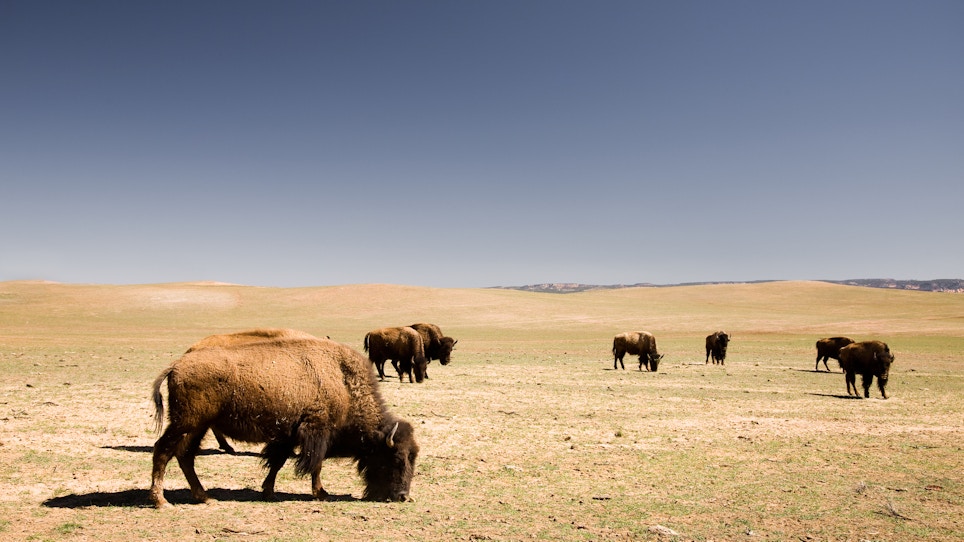The National Park Service wants YOU!
Are you physically fit, a good shot and a big-time believer in conservation? If so, the National Park Service (NPS) wants you — rather, needs you — to help with a current problem it’s facing.
The NPS is planning to thin the bison herd in the Grand Canyon between October of this year and May 2018, according to The Associated Press. Some of the herd will be shipped out of the area, while the remainder of the tag limit will be hunted legally.
Before you get too excited and start packing your bags, Grand View Outdoors Editorial Director Bob Robb, an Arizona native, said the discussion has been going on for “years and years,” and the answer isn’t as easy as the NPS wants you to think.
“It’s finally gotten to the point they’re like, ‘Man, we’ve got to do something,’” Robb said. “The park people, who are mostly anti-hunting, are even saying they have to do something.”
Robb isn’t among those who believe trapping and relocating the bison will work due to the large population. He goes on to say the NPS could either hire professional hunters to cull the population, a model some cities employ to manage deer herds, or the agency could make culling the bison something that’s achieved through legal hunting and, in turn, create revenue that could be used to fund wildlife and land management projects.
“The big question has been, do you allow sports hunting in the park,” Robb asked. “Let me give you some background. If you go north to Yellowstone Park, there’s a giant bison herd. You’re not allowed to hunt inside Yellowstone, but what happens is those bison migrate every year and go onto private and public land, and that’s how herd is culled. There’s been controversy over that forever. The reason they do it is because there’s too much damn buffalo.”
I’m in. How do I get a tag?
Lucky applicants will be selected through a lottery, the AP reports. While details are still being worked out, it’s reported the NPS is following previously similar hunts in national parks in Colorado, the Dakotas and Wyoming, where hunters were asked to help with an overabundant elk population.
Based on his experience of hunting bison in Alaska, Robb has an idea of how the hunts could be organized. While living in the state, Robb took a mandatory class after winning a tag for a cow. The class explained each type of bison and went through many other details considered relevant to the hunt. Once Robb filled his tag, processing the animal was “very controlled,” including a blood sample taken from the animal.
It’s said about 600 bison live in the region currently, but biologists predict the number could hit 1,500 within 10 years if left uncontrolled.
As many hunters know, winning the a tag lottery is no easy task. For Arizona, the AP reports that 1,500 people applied for the 122 regular bison tags this year. For this type of hunt, it can be even more difficult. North Dakota’s Theodore Roosevelt National Park spokeswoman Eileen Andes told the AP that 240 volunteers were chosen from thousands of applicants in 2010 for their elk reduction hunt. She added that some hunters quit before the week was over.
I’m still in. How physically fit do I need to be?
Well, have you read Bowhunting World editor Jace Bauserman’s Fit Bowhunter series? To get an accurate idea of how fit is fit enough, that’s a good start.
Hunters will search for bison in the open, Park Service spokesman Jeff Olson told the AP. Those hunting will do most of their work on foot, reaching elevations of 8,000 feet or higher when the road to the Grand Canyon’s North Rim is closed. Park officials say snowmobiles and sleds will be used to remove the meat.
Carl Lutch, terrestrial wildlife manager for the Game and Fish in Flagstaff, told the AP that some volunteers will “hike eight miles a day, carrying a 60-pound pack and hitting a paper plate 200 yards away five times.”
Anything else I should know?
If you win the lottery and make the trip, don’t plan to return home with a head or hide. The AP reports those will be given to tribes or federal and state agencies.
If you want meat, however, start planning recipes. The news source reports bison meat will be split among volunteers or, at least, that’s one scenario. If that’s the plan that sticks, each volunteer will be allowed to take the meat equivalent of one full bison.
What do you think about this opportunity? Would you go? Are you going to apply? Comment below and let us know.
Featured image: iStock






